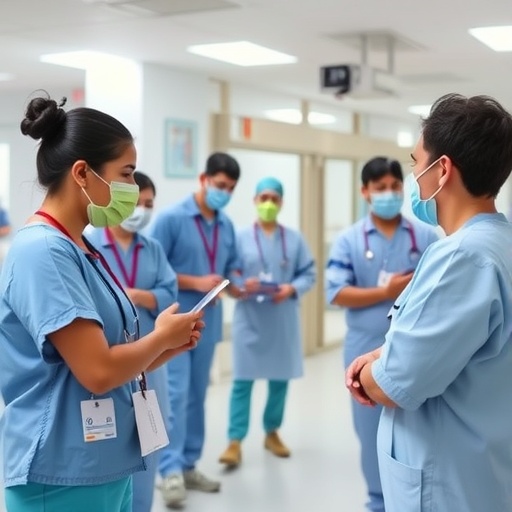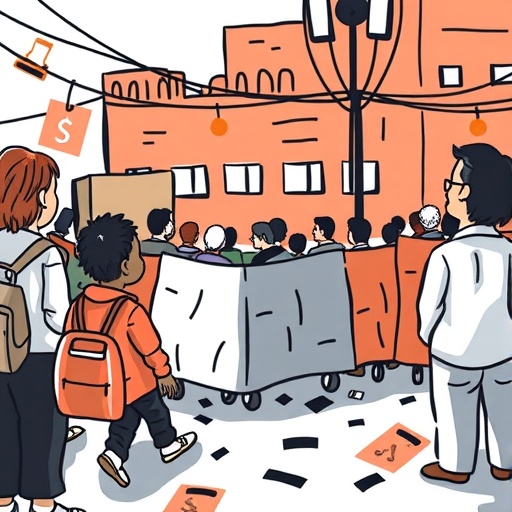In recent years, the focus on patient safety culture has emerged as a critical component of healthcare quality, especially in teaching hospitals where training and learning are pivotal. A comprehensive study conducted by Aires-Moreno, Marques, Sodré, and colleagues explores this important aspect within a teaching hospital in Brazil. As patient safety remains a paramount concern globally, understanding the perceptions of healthcare professionals and staff regarding safety culture can reveal significant insights that could lead to actionable changes aimed at improving patient outcomes.
The study engages healthcare administrators, clinical staff, and academic personnel by assessing their views on the prevailing patient safety culture within their institution. Recognizing the challenges posed by a multi-faceted healthcare environment, especially in teaching hospitals which serve as training grounds for future practitioners, the research examines how varying roles within an institution can influence perceptions of safety. The diverse experiences of the staff not only shape individual beliefs but also contribute to an overarching environment that either fosters or hinders safety protocols.
A critical element of the research methodology involved utilizing validated surveys to collect data regarding staff perceptions of patient safety culture. This approach allowed researchers to quantify feelings about communication, teamwork, and the overall organizational climate. The findings indicate that while there are areas of strength, significant gaps also exist, highlighting the need for targeted interventions. Enhanced communication and strengthened teamwork were marked as areas ripe for development, paving the way for policies designed to encourage a more holistic approach to patient safety.
The researchers also took into account the emotional and psychological dimensions of the workplace environment. Stress, frequent patient load, and competing priorities can significantly affect how safety protocols are perceived and enacted. The study emphasizes that a supportive environment, where staff feel empowered and valued, correlates strongly with positive safety culture metrics. Thus, ensuring the well-being of hospital staff becomes not just an ethical obligation but also a strategic imperative for enhancing patient care.
Furthermore, accountability emerged as a key theme within the findings. Participants expressed a need for clearer structures that define responsibility regarding patient safety. Without robust accountability measures, employees reported uncertainty around whether they could rely on their peers or supervisors to uphold safety protocols. Establishing an ethos of accountability within the hospital could transform perceived weaknesses into strengths; therefore, institutional policies that delineate roles and responsibilities become vital.
Education and training resurface as critical factors influencing perceptions of patient safety culture. Ongoing education initiatives can bridge knowledge gaps regarding safety protocols and best practices, fostering a more informed workforce. The study highlighted the importance of continuous professional development, which not only enhances skills but can also solidify a collective commitment to patient safety among healthcare professionals.
In conjunction with educational efforts, the study suggests that leadership plays a profound role in shaping safety culture perceptions. Transformative leadership that prioritizes open communication and feedback loops can significantly alter the workplace dynamics. Leaders who are approachable and committed to institutional safety can inspire similar values among their team, creating a culture where safety becomes a shared responsibility.
Intriguingly, the researchers found that the level of engagement in safety initiatives varied significantly across different departments within the hospital. Some units demonstrated higher rates of participation in safety initiatives, which correlated with lower incident reports. Conversely, departments that lacked engagement showed increased rates of adverse events, underscoring the critical need for institution-wide motivation towards safety involvement. This illustrates how departmental culture can impact overall patient safety outcomes.
The findings of the study also correspond with international trends where the understanding of patient safety culture is evolving. Comparative analyses with similar institutions worldwide highlight shared challenges and reveal that Brazil is not alone in grappling with these complex issues. Learning from global best practices offers immense potential to improve local safety measures, and the study advocates for leveraging international partnerships to facilitate knowledge exchange.
Another vital consideration raised by the study is the role of technology in enhancing patient safety cultures. Technological advancements, when integrated thoughtfully, can streamline communication and improve reporting mechanisms for safety incidents. The research suggests that the absence of user-friendly technology tools can deter staff from engaging in safety reporting, which is essential for institutional learning and safety improvement initiatives. To this end, hospitals must invest in both technology and training, ensuring that staff are equipped to use new systems effectively.
As the discourse on patient safety culture evolves, the implications of the research extend beyond the hospital environment. Community engagement and public awareness about patient safety can further enhance the pressure on healthcare institutions to prioritize safety. Educated patients, who understand their rights and the safety measures being implemented, can become advocates for patient safety within the system, influencing care quality through collaborative efforts.
In conclusion, the revelations from this comprehensive study provide a framework for enhancing patient safety culture in hospitals. By addressing perception gaps among staff, fostering an accountable and communicative environment, investing in education and technology, and promoting a proactive approach toward safety engagement, teaching hospitals can pave the way for meaningful improvements in patient care. This research not only sheds light on the experiences of a Brazilian teaching hospital but also serves as an urgent call to action for healthcare systems worldwide to prioritize the safety and well-being of their patients.
Subject of Research: Perceptions of Patient Safety Culture in a Teaching Hospital in Brazil
Article Title: Perceptions of patient safety culture in a teaching hospital in Brazil.
Article References:
Aires-Moreno, G.T., Marques, L.G., Sodré, M.M.X. et al. Perceptions of patient safety culture in a teaching hospital in Brazil.
BMC Health Serv Res 25, 1427 (2025). https://doi.org/10.1186/s12913-025-13190-x
Image Credits: AI Generated
DOI: 10.1186/s12913-025-13190-x
Keywords: patient safety culture, healthcare, teaching hospital, Brazil, perceptions, communication, accountability, technology, education, leadership.
Tags: challenges in patient safetyhealthcare staff communicationimproving patient safety protocolsmulti-faceted healthcare environmentorganizational climate in hospitalspatient safety culture in Brazilpatient safety outcomesperceptions of healthcare professionalsteaching hospital healthcare qualityteamwork in healthcare settingstraining future healthcare practitionersvalidated surveys in healthcare research





